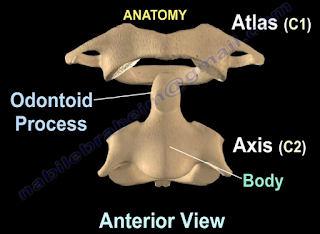Fifty percent of patients with Jefferson fractures will have
associated spine injuries. The canal is wide with a low risk of spinal cord
injuries unless the transverse ligament is disrupted. It is difficult to view
Jefferson Fractures on an x-ray (usually seen on the lateral side”. This
fracture is considered a “Junctional Fracture” and could be missed. The classic
Jefferson fracture is a burst fracture that results from an axial load. It
could be a four part fracture with bilateral fractures of the anterior and
posterior arch. There are variations which include two and three part fractures
and incomplete formations of the posterior arch can be mistaken as a fracture.
When speaking of Jefferson fractures, it is important to be
familiar with the structures that may be involved. These bony structures
include: The Atlas (C1), Axis (C2), and the odontoid process. C1 and C2 are
stabilized together by the transverse ligament and C1 and C2 provide a 50% of
rotation of the neck. The C1 is a ring. At the upper cervical region, the
spinal canal is 2.5 times larger than the cord size. The stability and
treatment of Jefferson fractures depends on the integrity of the transverse ligament
and the displacement of the fracture. You need to know about the important
ligaments related to the Jefferson fracture. These ligaments include: the
transverse ligament, the apical ligament, and the Alar ligament.
Diagnosing ligamentous injury
In order to determine a ligamentous injury, the physician
will want to check the Atlanto-dens interval (A.D.I). Normally, this interval should
be less than 3mm in adults and less than 5mm in children. If the ADI is between
3-5mm, this indicates an injury to the transverse ligament; the transverse
ligament holds the odontoid and C1 together, alar and apical ligaments will be
intact. If the A.D.I measures greater than 5mm, then there is an injury to the
transverse, alar, and apical ligaments.
Fracture Types
A bony injury with the intact transverse ligament and a
lateral mass displacement less than 7mm and the A.D.I is less than 3mm is
considered a stable fracture. Nondisplaced fractures of this nature should be
treated with a rigid orthosis. If the fracture is displaced, a halo will need
to be used.
Another type of fracture can occur at C1 with a transverse
ligament tear. The Atlanto-dens interval will be more than 3 mm in adults. The
treatment will depend on the type of injury to the transverse ligament. With
bony avulsions of the transverse ligament, the halo will need to be used
cautiously. However, some surgeons prefer to do a fusion of C1 and C2. If there
is an intrasubstance tear of the transverse ligament, the surgeon will perform
a fusion at C1-C2. The surgeon will need to do early surgery as this is a
significant injury with a risk of spinal cord compression.
In regards to “Open Mouth Views”, the normal overhang is visible
during an “Open Mouth View”. If it is just a bony injury Jefferson fracture, the
combined overhang will be less than 7mm and the transverse ligament is intact
and it is a stable fracture. If a Jefferson fracture has a combined overhang of
more than 7mm, then the transverse ligament is probably torn and there is an
unstable fracture present.
Radiological Studies
A CT scan is probably the best study in diagnosing the
characteristics of the bony injury. An MRI is the best study in diagnosing any
associated transverse ligament injuries.




